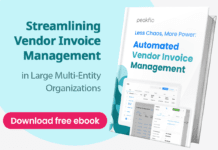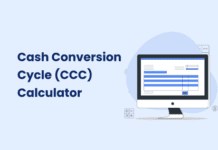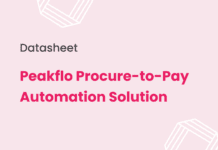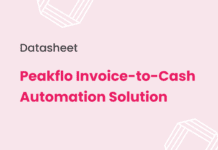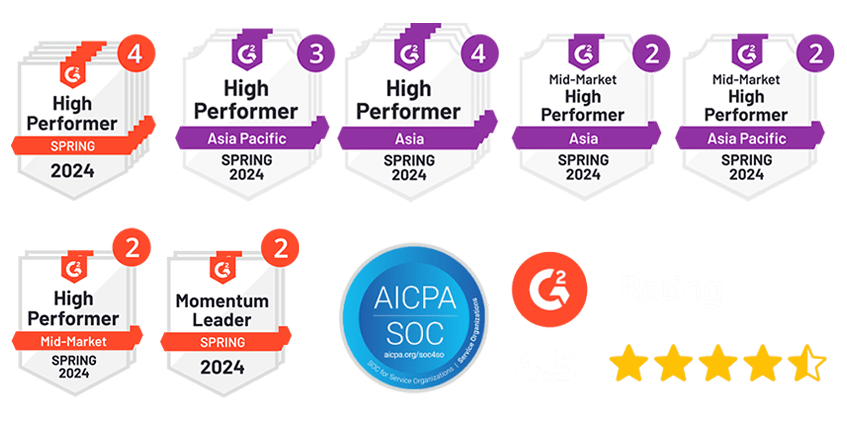If you run a business or work in finance and accounts, you understand how important invoice management is. Handling many invoices can be complicated, time-consuming, and prone to mistakes, which can lead to late payments and harm your business’s reputation.
A report by Ardent Partners shows that 42% of accounts payable professionals see the high cost of processing invoices as a significant issue.
Invoice management plays a crucial role in the smooth functioning of businesses across various industries. Efficient invoice management ensures timely payments, accurate record-keeping, and effective financial control.
In this article, we will explore what invoice management is, why it is important, the biggest challenges associated with it, the process of invoice management, and the different types of systems to manage invoices – manual and automated.
We will also discuss the pros and cons of each approach to help you determine which one is better suited for your business.
What is Invoice Management?
Invoice management is an essential business function that supports the procurement process. The goal is to manage supplier invoices to ensure timely payments and verify the legitimacy of invoices.
The steps in invoice management are:
- Receiving the invoice
- Reviewing the details
- Validating the invoice information
- Approving the payment
- Recording invoices and transactions in a database
In other words, invoice management is the process of handling invoices, from their creation and submission to the final payment and archiving. It involves activities such as verifying invoice accuracy, matching invoices with purchase orders or contracts, obtaining approvals, resolving discrepancies, and making payments. Effective invoice management ensures that businesses have a clear overview of their financial obligations and can maintain strong relationships with their suppliers.
Why is Invoice Management Important?
Invoice management is vital for several reasons. Firstly, it helps businesses maintain accurate financial records, which are essential for tax compliance, financial reporting, and auditing purposes.
Properly managed invoices also enable businesses to track their cash flow, monitor operating expenses, and make informed decisions about budgeting control and resource allocation.
Additionally, efficient invoice management enhances relationships with suppliers. Timely payments and clear communication regarding invoice status foster goodwill and trust, leading to more favorable payment terms and conditions for future transactions.
On the other hand, poor invoice management can strain supplier relationships, potentially resulting in delayed deliveries or even discontinued services.
The Biggest Invoice Management Challenges
Despite its significance, invoice management can pose several challenges for businesses:
- Manual Processing: Handling invoices manually is time-consuming and prone to errors, leading to delays and inefficiencies. It requires significant human effort, often resulting in late payments, late fees, and strained relationships with suppliers.
- Complex Invoice Data: Invoices often contain large amounts of information, such as line items, tax details, shipping costs, and discounts. Manually extracting and validating this data can be cumbersome and error-prone, leading to inaccurate financial records and delayed payments.
- High Processing Costs: The cost of processing each invoice can be substantial, especially when relying on outdated systems and processes.
- Invoice Matching Issues: Matching invoices with purchase orders and receipts can be challenging and often results in discrepancies that need resolution.
- Approval Bottlenecks: In larger organizations, invoices may need to go through multiple layers of approval, causing delays and confusion. Coordinating the approval process manually can lead to bottlenecks and inefficiencies.
- Compliance Issues: Keeping up with regulatory requirements and ensuring compliance in invoice processing can be difficult.
- Lack of Visibility: Limited visibility into the invoice processing workflow can make it hard to track the status of invoices and identify bottlenecks.
What is the Process of Managing Invoices?
To address these challenges, businesses can adopt different approaches to invoice management: manual and automated. Let’s explore both methods in detail.
Manual Process
In manual invoice management, the entire process is handled manually, involving physical paperwork, manual data entry, and manual routing for approvals. This traditional approach is still prevalent in many organizations, especially smaller ones with fewer invoices to manage.
Manual invoice management requires businesses to receive paper invoices physically or via email. The invoices are then manually reviewed for accuracy and matched with relevant purchase orders or contracts.
The data from the invoices are entered into the accounting system manually, and approvals are obtained through manual routing or physical signatures. Finally, payments are made manually through checks or bank transfers.
Automated Process
Automated invoice management, on the other hand, leverages technology and software to streamline the entire process. With automation, businesses can eliminate manual data entry, reduce errors, enhance efficiency, and gain real-time visibility into their invoice workflows.
In an automated system, invoices are received electronically through email or electronic data interchange (EDI). Optical character recognition (OCR) technology is used to extract data from invoices accurately and automatically.
The data is then validated and matched with purchase orders or contracts using automated workflows. Automated approval workflows can be configured based on your organization’s approval matrixes. This will ensure that invoices are routed to the right approvers based on predefined rules and hierarchy, accelerating approval processes.
Once approved, the system generates electronic payments or initiates the necessary steps for payment processing.
Manual vs Automated Invoice Management: Which One Is Better?
The choice between manual and automated invoice management depends on various factors, including the size of the business, the volume of invoices, and the available resources. Let’s compare the two approaches to help you determine which one is better suited for your business.
Manual invoice management has some advantages. It can be suitable for smaller businesses with a lower volume of invoices as it does not require a significant upfront investment in technology.
It allows for more hands-on control over the invoice process, enabling businesses to closely review each invoice manually. Additionally, manual processes can be customized to fit specific business requirements and workflows.
However, manual invoice management has its limitations. It is time-consuming and prone to errors, which can result in delayed payments, inaccurate record-keeping, and strained supplier relationships. It requires a dedicated workforce to handle the manual tasks, diverting resources from more strategic activities.
Furthermore, manual processes lack real-time visibility and reporting capabilities, making it challenging to track invoice status and identify process inefficiencies.
On the other hand, automated invoice management offers significant benefits. By eliminating manual data entry, businesses can save time and reduce errors.
Automated workflows ensure invoices are routed to the appropriate approvers, reducing approval cycle times and increasing efficiency. Real-time visibility into invoice status allows businesses to address issues promptly, optimize cash flow, and maintain better supplier relationships.
Automation also enables businesses to generate accurate finance reports, analyze spending patterns, and make informed decisions based on reliable data. Integration with accounting software streamlines the entire financial process, improving accuracy and providing a centralized view of financial data.
While automated invoice management offers numerous advantages, it requires an initial investment in technology and implementation. It also requires training employees to use the system effectively.
Therefore, for smaller businesses with limited resources and a lower volume of invoices, the cost and complexity of implementing an automated system may outweigh the benefits.
However, as businesses grow and the volume of invoices increases, manual processes become less feasible and more prone to errors. At this stage, transitioning to an automated system becomes a strategic move to improve efficiency, accuracy, and scalability.
Benefits of an Automated Invoice Management Solution
Automated invoice management streamlines the entire process of handling invoices, from data entry to data storage, by integrating every step into a seamless, automated workflow. Here are the detailed benefits of using an automated invoice management system:
- Ensuring Timely Payments
Automated systems significantly reduce the time taken to process invoices and enable auto-disbursement. By eliminating manual steps, invoices are processed faster, ensuring that payments are made on time. This helps avoid late fees and maintains a positive cash flow. - Enhancing Vendor Relationships
Timely and accurate payments foster better relationships with vendors. An automated system minimizes errors and delays, making your business a reliable partner. This can lead to more favorable terms and better service from your suppliers. - Boosting Business Credibility
A streamlined invoice process enhances your business’s reputation for reliability and efficiency. Vendors and partners are more likely to view your company as a professional and trustworthy entity, improving your overall business credibility. - Reducing Processing Costs
Automation reduces the need for manual intervention, which lowers labor costs associated with invoice processing. Additionally, it minimizes errors that can lead to costly rework, further reducing overall processing expenses. - Improving Compliance
Automated systems ensure that all invoices are processed following regulatory requirements. This reduces the risk of non-compliance and potential legal issues, providing peace of mind and safeguarding your business. - Saving Time on Manual Processing
By automating repetitive tasks such as data entry and validation, significant time is saved. This allows your accounts payable team to focus on more strategic activities, increasing overall productivity and efficiency.
Manage Invoices Like a Pro
While manual invoice management has its place in smaller businesses with lower volumes of invoices, automated systems offer significant advantages in terms of efficiency, accuracy, and real-time visibility.
Embrace the right tools and systems, and unlock the benefits of efficient and accurate invoice management for your business. With solutions such as Peakflo’s Procure-to-Pay Automation, achieve efficiency and excellence in your invoice management process.
With Peakflo, say goodbye to laborious tasks and hello to a powerful solution that enables you to effortlessly handle payment reminders, streamline reconciliations, and breeze through month-end closing. Our comprehensive software empowers you to create, manage, and process invoices swiftly, reducing processing time by an impressive 50%.
FAQ
What is an invoice management system?
An invoice management system is a software solution that helps businesses handle the entire process of receiving, processing, and paying invoices. It automates tasks such as data entry, invoice approval workflows, and payment processing, improving efficiency and reducing errors.
What is invoice flow management?
Invoice flow management refers to the process of overseeing the movement of invoices through various stages, from receipt to payment. It involves managing the workflow, ensuring that invoices are processed promptly, and tracking their status at each stage.
Who needs an invoice management system?
Any business that deals with a significant number of invoices can benefit from an invoice management system. This includes small businesses, mid-sized companies, and large enterprises across various industries. It helps streamline the invoice processing workflow, improve efficiency, and reduce costs.
What is invoice management reporting?
Invoice management reporting involves generating and analyzing reports related to invoice processing. These reports provide insights into the number of invoices processed, the time taken to process them, any bottlenecks in the workflow, and other key metrics. This information helps businesses make informed decisions and improve their invoice management processes.









![Why AI Sales Calls Are Making Good Sales Reps Even Better [2025 Guide] ai sales calls](https://cdn-kmjmp.nitrocdn.com/YvtqmrsiHUxqerlSiZgbfzqqTARWTElr/assets/images/optimized/rev-834053b/blog.peakflo.co/wp-content/uploads/2025/09/65168cf6-3001-4733-8cbc-12d5684cf449-218x150.webp)







